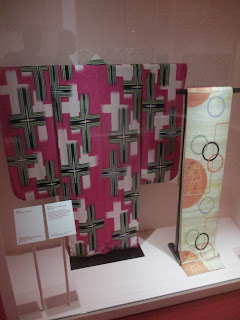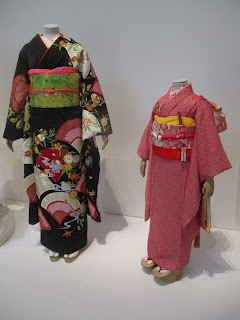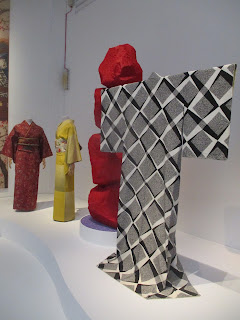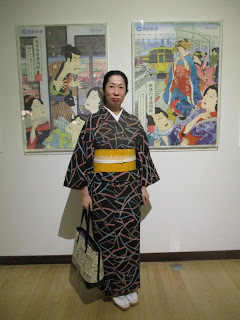'From the sophisticated cuture of 17th-century Kyoto to the creativity of the contemporary catwalk, the kimono is unique in its aesthetic importance and cultural impact, giving it a fascinating place within the story of fashion' - Anna Jackson, curator of Kimono: Kyoto To Catwalk
Kimono installation view
Following on from the success of the blockbuster that was Christian Dior: Designer of Dreams last year, the V&A presents another beautifully designed fashion exhibition in Kimono: Kyoto to Catwalk. The exhibition looks at the social and sartorial history of the kimono garment worn by 17th-century Japanese actors and courtesans, and how the kimono has been adopted and altered by the West for use in fashion and film. Kimono are both unisex and utilitarian, and the literal translation of kimono is 'a thing to wear'. The exhibition features 300 examples of the garment including rare 17th and 18th century kimono on loan from private collections. There are also a variety of Japanese woodcut prints on display depicting the sumptuous, patterned fabric designs, and the various accoutrements of Japanese craft associated with kimono wearing such as lacquerwork, blue and white porcelain, and intricate ivory carvings. The first section explains how although the garment is traditionally fairly simply constructed, it may compensate for this with rich, embroidered embellishments. There are also more structured kimono with complex pleating. It is also explained how in Sixteenth Century Kyoto a thriving fashion culture developed from the burgeoning merchant classes, and how restrictive social constructs kept this in place, freezing out the lower societal classes. Certain subtle features of a kimono would denote your social standing, such as the width of the sleeve. In this first half of the exhibition all of the kimono are beautifully presented in a series of tableau behind glass display cases because of their age and fragility. Many may never be exhibited again because they are so delicate.

A John Galliano design for Dior SS 2007, based on kimono designs
Kimono: Kyoto to Catwalk installation view
The next section of the exhibition deals with Japan's trading links to the West via Dutch traders. It also looks at the influence and impact of Japonism in general, and the kimono on dress in Victorian-era Western society. This is depicted through period oil paintings showing the earliest Western adaptation of the kimono, orientalised bustle dresses, as well as period catalogues of kimono design from which the fashionable lady of means could have her kimono made to order.
Gerard Hoet - Anna Elizabeth van Reede, 1678
This section of the exhibition showing how early 20th C. designers adapted the design of the kimono to create looser, less form-fitting clothes was a favourite of mine. I am an admirer of Paul Poiret's fashion designs created for his haute couture fashion house, and it was a real thrill to finally be able to see one of his Mantle dresses (yellow dress, below), with its relaxed structure at close quarters.
Kobayakawa Kiyoshi - 'Kaidan' ( staircase), hanging scroll, 1935
This small mirrored section of the exhibition displays how kimono are basically a blank canvas for designers to express themselves through politics, social comment or sexually. The seemingly infinite variety of representational or abstract patterned designs which have been used to adorn the kimono are on show here. Many weren't just decorative, but celebrated the arrival of certain technologies such as flight, with the depiction of aeroplanes, and also communication with a telegraph pole design. Others had fabrics printed with important global events on them such as sporting events in the Olympic Games.
The last room of the exhibition is again beautifully presented with the initial section focusing on traditional embroidery techniques, and bold, graphic, printed pattern in modern and contemporary kimono. The exhibition then goes on in the end section to illustrate how contemporary fashion designers have appropriated kimono design for couture fashion, and film and music performances. The kimono aren't presented behind glass in this section so you get better chances to examine them without the distracting reflection from the glass presentation cases. I doubt I will see a better designed and presented exhibition again for the rest of the year.
Kimono: Kyoto to Catwalk installation view
Traditional kimono designs adapted for musical performance are included above. The wearers from left to right include Freddie Mercury, who's kimono is soft and feminine playing with gender roles, whilst Madonna's, (designed by Jean-Paul Gaultier for her Nothing Really Matters music video), is structured and dramatic in a particularly vibrant shade of red. Björk's kimono, on the right (designed by Alexander McQueen for her Homogenic album cover), is equally dramatic and severe in its structure. Whilst those adapted for film include Toshiro Mifune's dark kimono for the Akira Kurosawa film Sanjûrô, on the left, below, and the Star Wars costume for the character of Obi-Wan Kenobi (right) designed by John Mollo on the right.
Visitors who haven't had enough kimono in the exhibition can get a further fix in the V&A's Japan galleries on the ground floor where they can spot the following beauties, and other artefacts and artwork relating to the history of the kimono. The detail and intricacy involved in the decorative embroidery is stunning.
An unexpected bonus of this exhibition was seeing visitors who were of Japanese heritage, or had strong links to Japan, gamely showing off their pride in their culture and sporting their own kimono. Some of the kimono were actually antique pieces passed down through their families.
Kimono: Kyoto to Catwalk
until 25th October
Victoria and Albert Museum
Cromwell Road
London
SW7
























































No comments:
Post a Comment